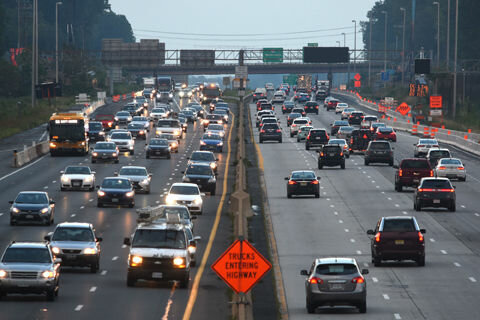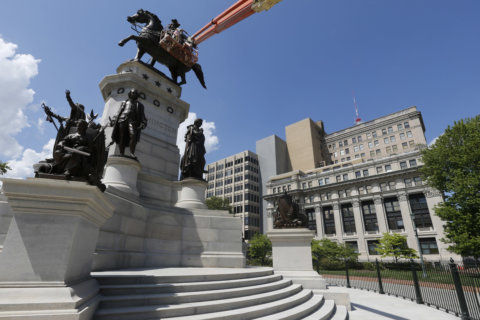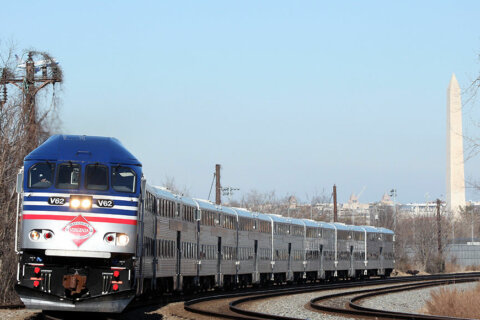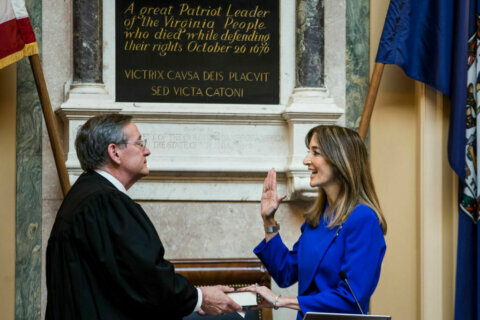
New fees, speed cameras and a handheld cellphone ban are some of the measures on the horizon for Virginia drivers under a wide-ranging transportation bill proposed by Gov. Ralph Northam and Democratic leaders of the state’s General Assembly.
The proposal also includes previously announced plans to end car inspections, raising the gas tax 4 cents per year for the next three years and indexing it to inflation thereafter, and cutting car registration fees approximately in half.
The General Assembly could still make significant changes to the proposals in coming weeks.
Gas tax hike
The state gas tax would rise to 20.2 cents per gallon starting July 1, 2020; 24.2 cents per gallon on July 1, 2021; and 28.2 cents per gallon on July 1, 2023. After that, it would be indexed to inflation. The state diesel tax, meanwhile, would rise to 20.2 cents per gallon July 1, 2020, and 27 cents per gallon July 1, 2021, then be indexed to inflation moving forward.
The additional regional gas taxes in Northern Virginia, Hampton Roads and along the Interstate 81 corridor would also be set at fixed rates that would rise each year with inflation.
Fee for fuel efficiency
Since the gas tax is one of Virginia’s key funding sources for road projects, the Northam administration is proposing a fee on fuel-efficient vehicles to ensure users pay something closer to the amount that they use when it comes to roads.
Fuel-efficient vehicles would be those with a combined miles-per-gallon rating of 25 or greater, electric vehicles, or alternative fuel vehicles that run on something other than gasoline or diesel.
“The highway use fee is intended to try and ensure more equitable contributions to our system, again without penalizing people that have made [environmentally sound] decisions,” Deputy Transportation Secretary Nick Donohue said.
Under the plan, drivers would pay 85% of the difference between the gas tax paid by an average vehicle on Virginia’s roads today, which gets around 23.7 miles per gallon, and what the driver of a fuel-efficient car would pay based on the statewide average number of annual miles driven.
The fees would be updated annually.
For example, if the average car were paying $100 in state gas taxes, but the more fuel-efficient car would pay $80, then the additional annual fee would be around $17. An electric car owner would pay around $85 under that scenario.
The owners of fuel efficient cars would still save money compared to other drivers overall since they still use less gas.
“The [state] tax on gas is a very, very small portion of the actual savings a driver of a fuel-efficient vehicle realizes,” Donohue said.
Combined with the gas tax increases and proposed reduction or elimination of flat-rate registration and inspection fees, Donohue said it makes the system fairer.
“What these changes kind of collectively do is have people who use our system contribute more based on use, also whether or not they live in or out of state,” Donohue said.
Donohue said this proposal factors in complaints about the 2013 flat fee on hybrid drivers that led to significant pushback, and aims to avoid penalizing drivers who buy more fuel efficient or electric or alternative-fuel cars.
Local governments would be able to continue charging additional local registration fees at the current levels.
Fee per mile
As an alternative to the fuel-efficiency payment, Virginia drivers could sign up for a pilot program with the Department of Motor Vehicles to pay a fee for every mile they drive.
The system is already being tested elsewhere in the country, and Virginia is participating in a regional effort to look into it for the Interstate 95 corridor.
In this case, the incentive to join the pilot would be for drivers of fuel-efficient or electric vehicles who drive less than the average number of miles, so that they could lower their payments.
The state would then get data and evidence on whether such a program could work in the state on a broader scale and replace the gas tax in the future.
“Sustainable transportation funding is the goal,” Transportation Secretary Shannon Valentine said.
Like other states trying out the program, no one would be forced to do it.
The law would also limit the charges in any 12-month period to no more than what the driver would have paid under the fuel-efficient vehicle fee.
There could be a limit on the number of people enrolled in the mileage-based fee program for its first four years.
Safety measures: Cellphone, open container bans
The changes also include a variety of safety proposals.
Drivers would no longer be able to hold a cellphone while driving, police would be able to pull people over for failing to wear a seat belt, and local governments could lower speed limits in business or residential districts to less than 25 mph.
The bill would also allow stationary speed cameras in certain corridors for the first time in Virginia.
Speed cameras would be allowed on interstates and primary roads designated as safety corridors, where Virginia State Police could issue tickets to anyone going at least 10 mph over the speed limit. Unlike tickets issued during traffic stops in those areas, the fines would not be doubled for tickets drivers get in the mail.
As in other states, police would have to post a sign saying that the speed limits are photo-enforced.
Yet another proposal would ban open containers of alcohol in the passenger area of a vehicle.
Virginia law currently permits open containers in the car as long as the driver has not been drinking. Changing the law would comply with federal requirements and free up some Virginia funding. The new law would still permit drinking by passengers in limousines and party buses, in the living area of an RV and in parking lots.
Along with an increase in funding earmarked for safety projects and a new five-year highway safety improvement plan, the Northam administration said it believes the safety changes could cut road deaths by up to 20%, saving around 150 people per year.
More than 800 people were killed on Virginia roads in 2019, a significant increase from just five years ago.
The seat belt law, handheld cellphone ban and open container changes would not take effect until July 1, 2021, to give time for education and training of drivers and law enforcement.
The Department of Motor Vehicles would establish an advisory council to make sure minorities are not disproportionately pulled over and punished under the new safety laws.
Financial shifts
The proposed changes would raise a projected $190.4 million in the first year, followed by $366.3 million in the second year, $548.8 million in the third year and $601.4 million in the fourth year.
Those increases, which would include gas taxes paid by out-of-state drivers, would be offset by the approximately $163 million Virginia drivers would not have to pay due to lower registration fees starting in the second year.
Registration fees would be cut by $20 for passenger cars and pickup trucks, but would remain flat for motor homes. Motorcycle and moped registration fees would be cut by $4 to $8.
Drivers would also save through the proposed elimination of car safety inspections, although there are already signals that a compromise on that could lead to simply reducing the frequency of the inspections to something like every other year rather than eliminating them entirely.
The overall proposal also largely ends the practice of designating specific statewide taxes for specific types of transportation, such as transit or roads, and instead would maintain the current ratios among different modes but put the money coming in all in one pot.
“We really are stabilizing all modes of transportation, we rise and fall together, and you’re all allowed to grow,” Valentine said.
Some of the new money would also be shifted to cover about $65 million per year in transportation costs currently paid for through general fund dollars.
The remainder would significantly increase the amount of money available for road projects, safety work, transit and paving, while also providing a long-term state match for federal Metro capital funding and establishing new money for maintenance and reconstruction of large special structures, such as bridges and the deck over I-66 in Rosslyn over coming decades.
The bill also restores $30 million to $45 million per year to the Northern Virginia Transportation Authority that was shifted to Metro by raising the hotel stay tax and grantor’s tax in Northern Virginia.
The General Assembly could also authorize bonds to help speed up I-81 upgrades, restructure regional gas taxes to set values that rise with inflation rather than the current 2.1%, and provide funds to link a bridge between Kentucky and Virginia to other roads.
Sales taxes and regional gas taxes would remain crucial sources of transportation funding in the state.
New rail agency
As part of the major increase in VRE and Amtrak service coming to the state, a new Virginia Passenger Rail Authority would own and manage the new tracks and land, in part to insulate the state from liability issues and also keep the state from selling off this asset again.
The new authority would have a 10-member board. That includes four citizen members from parts of Virginia served by Virginia Railway Express, two members from the Richmond area, one member from Hampton Roads and one member from the part of western Virginia served by Amtrak. An Amtrak official and Virginia’s Director of Rail and Public Transportation would also be on the board.
The bill also allows debt backed by I-66 inside the Beltway toll revenues to pay for Long Bridge construction. The Northern Virginia Transportation Commission is due to approve that this week.
The governance model was one of those recommended by a group of legal experts, Valentine said.
The changes would not impact VRE’s governance, and the state does not plan to directly operate trains on its own. As the state does today, the board would reach agreements with Amtrak and VRE on service plans and required fees.
The plan also includes trains later at night for VRE and Amtrak, which could make the train a more realistic option for people who cannot be sure of getting off work around 5 p.m. or who want to stay in D.C. a bit longer.
For transit agencies, the bill would set up a program aimed at increasing ridership by implementing bus-only lanes and incentivizing more cross-jurisdictional service. Up to a quarter of the money in the transit incentive program could be used to offer discounted fares for low-income riders or to eliminate fares entirely on some or all routes.







